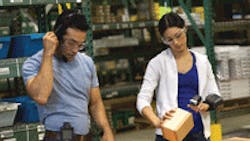Industry Just Tapping its Mobile Potential
Field operators at Huntsman Chemical have traded clipboards for handhelds -- and have eliminated safety incidents at a rewarding rate.
Instead of using pens and paper to record critical field data, Huntsman's operators at its facility at Port Neches, Texas, are using wireless mobility technology to complete operating condition procedures, identify defects on equipment and oversee inspections.
Huntsman Chemical is one of a wave of companies that are adopting industrial wireless applications, using the technology to tie together mobility and real-time data. Though wireless has been available for years, only now is it beginning to see widespread adoption.
According to a report recently published by wireless provider Apprion, 64% of facilities surveyed have at least one wireless application already installed. The study goes on to show that from April 2009 to April 2010, wireless adoption increased 23%, while sites currently considering wireless applications grew by 85%.
Coca-Cola installed a voice-picking application throughout its 100 largest warehouses in North America for a fraction of the cost other companies have spent in recent years by using a voice-over-IP phone as opposed to a more industrially focused and costlier system.
"Typically, the application resides on a small computer," explains Mike Jacks, senior manager of logistics systems at Coca-Cola. "What we've done is taken the application and rather than put it on a small computer, we've put it on a server bay. There's really nothing loaded onto the phone."
Warehouse operators dial into the system when they arrive at work and immediately receive detailed information on what to pick and where to place -- all via voice. Throughout the day, it's one continuous call, updating constant streams of data.
"With more standard voicepicking systems, you'd have proprietary software and you'd have proprietary hardware," says Jacks. "The biggest difference for us is the way we're able to deliver our system to the pickers. Most systems end up costing $1,500 per picker. For us, it's just a $350 phone."
A device like the Google Android, with its full keyboard and high-resolution screen, can easily be applied in a manufacturing workspace -- and at a fraction of the cost.
"As we start to see many of the more proprietary systems that have been in place with industrial protocols in the traditional manufacturing environment merging now with IP, that creates a lot more opportunity to use more off-the-shelf commercial technology," says Chris Kozup, director or wireless and mobility solutions groups at Cisco.
Still, some questions remain with mobility, specifically where it can be easily applied -- and where there are limitations of use.
Meanwhile, production supervisors are able to track rates of production and leverage that data to see a long-range picture going forward.
But the picture is far less clear for production operators. According to Ralph Brio, an analyst for ARC Advisory, mobile technology is contingent on wireless accessibility. If, for any reason, an operator is out of range and is no longer receiving up-to-date data, it could cause decisions to be made based off incorrect data, creating the potential for disaster.
"My sense is that the production operators will someday have a wired solution and occasionally there will be places where the real-time nature isn't quite as important," says Brio. "But based off my studies on the issue, it comes down to this: Think of the big red button that emergency stops a machine. When an operator whacks that, things have got to stop. When it's wireless, there's some concern if that signal doesn't come in."
Still, some view the technology evolving quickly and believe industrial users are only now beginning to tap its potential.
"This is about the digitization of the information-gathering process on the plant floor," says Manoj Mathew, practice head for Infosys' engineering and product lifecycle solutions business. "It's about using mobility with an eye toward improving operating efficiency and getting people to use that data as a competitive advantage."
See Also:
• Researchers Tap Gaming Technologies For Training Workers
• Switching the Way We Shrink Computer Chips
